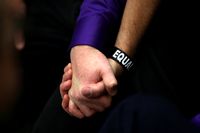The number of same-sex couples who call New Jersey home increased significantly over the last 10 years, according to the latest census figures.
There are 24,112 same-sex couples living in New Jersey — a 45 percent increase from 2000, according to the 2010 Census. By comparison, New York City has 32,972 same-sex couples.
The sharpest increase was in Asbury Park, which had a 305 percent gain in the same sex couples. Hoboken (70.7 percent increase), Jersey City (44.2 percent) and Newark (12.7 percent) all saw significant increases.
Anthony Newarski and his partner Rick Goeden are among the 243 same-sex couples who live in Asbury Park.
Newarski, who helps run John C. Conover real estate agency, said the neighborhood has been transformed by gay couples moving into the area.
“Ten years ago, probably 50 percent of these houses were boarded up or they were rooming houses,” he said. “Beautiful Victorians were chopped up into boarding houses, and the gay community started coming in, buying them up, fixing them up, making them back into single, beautiful homes.”
Amy Quinn, an attorney and vice chair of the Monmouth County Democratic Committee, said gay rights groups strongly encouraged members to fill out their census forms accurately.
“Particularly with marriage equality being a hot button issue in areas like New York and New Jersey, our community wanted to ensure we were properly counted,” Quinn said. “We understand that our political power lies in our own visibility.”
The census also revealed that the Asian population grew by nearly half — by 275,862, or 52 percent. Nearly half that growth came from the Asian Indian community, which added 130,353 people, a 72 percent increase from 2000.
The state’s Chinese population grew by 35 percent, or 36,470, while the Korean and Filipino count each grew by a little over 31,000.
The state’s Latino population grew by 39 percent. The greatest demographic shift, among Latinos, took place within the state’s Mexican community, which added another 114,786 residents, more than doubling its numbers. That makes it half the size of the state’s Puerto Rican population, which is 434,092.



